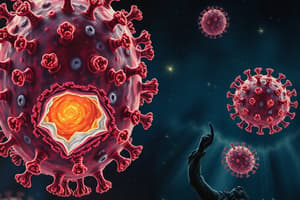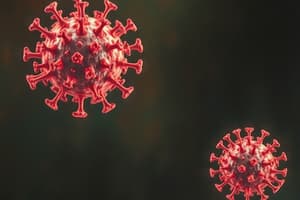Podcast
Questions and Answers
What is the primary factor influencing a virus's ability to attach to a host cell?
What is the primary factor influencing a virus's ability to attach to a host cell?
- The availability of transcription factors
- The timing of viral replication
- The internal conditions of the virus
- The presence of cellular receptors on the host cell (correct)
Which process describes how a virus enters a host cell after attachment?
Which process describes how a virus enters a host cell after attachment?
- Transcription
- Osmosis
- Endocytosis (correct)
- Exocytosis
What does the eclipse period refer to in the context of viral replication?
What does the eclipse period refer to in the context of viral replication?
- The duration between infection and new virion production (correct)
- The time taken for viruses to mutate
- The period when viral components are assembled
- The time viruses remain dormant in host cells
What might happen to the chances of viral spread during a longer eclipse period?
What might happen to the chances of viral spread during a longer eclipse period?
What crucial requirement must be met for positive attachment of a virus to a host cell?
What crucial requirement must be met for positive attachment of a virus to a host cell?
Which statement accurately describes the characteristics of RNA viruses compared to DNA viruses?
Which statement accurately describes the characteristics of RNA viruses compared to DNA viruses?
What is meant by viral tropism?
What is meant by viral tropism?
Which of the following virus classifications includes the influenza virus?
Which of the following virus classifications includes the influenza virus?
What characteristic is shared by all viruses mentioned in the content?
What characteristic is shared by all viruses mentioned in the content?
Which type of viral symmetry does the herpes virus exhibit?
Which type of viral symmetry does the herpes virus exhibit?
What is the primary function of the eclipse phase during viral infection?
What is the primary function of the eclipse phase during viral infection?
Which process describes the direct fusion of the viral envelope with the host cell membrane?
Which process describes the direct fusion of the viral envelope with the host cell membrane?
Which step directly follows the uncoating of a virus?
Which step directly follows the uncoating of a virus?
What role do non-structural proteins play in a virus?
What role do non-structural proteins play in a virus?
Where can viral assembly occur within a host cell?
Where can viral assembly occur within a host cell?
What is the outcome of lytic replication?
What is the outcome of lytic replication?
Which of the following accurately describes the role of mRNA in the viral life cycle?
Which of the following accurately describes the role of mRNA in the viral life cycle?
What primary function does the capsid serve for a virus?
What primary function does the capsid serve for a virus?
In what way do viruses differ from bacteria regarding their ability to reproduce?
In what way do viruses differ from bacteria regarding their ability to reproduce?
What does a virus lacking an envelope refer to?
What does a virus lacking an envelope refer to?
What component of a virus is responsible for its classification based on symmetry?
What component of a virus is responsible for its classification based on symmetry?
What is the approximate size range of most viruses?
What is the approximate size range of most viruses?
Which nucleic acid type can viruses contain?
Which nucleic acid type can viruses contain?
Which of the following structures would you find in a virus with an envelope?
Which of the following structures would you find in a virus with an envelope?
What is the significance of the viral envelope during the infection process?
What is the significance of the viral envelope during the infection process?
During which viral structure formation does symmetry play a vital role?
During which viral structure formation does symmetry play a vital role?
Where do viruses predominantly exist compared to the number of stars in the universe?
Where do viruses predominantly exist compared to the number of stars in the universe?
Flashcards are hidden until you start studying
Study Notes
Viral Entry and Replication
- Viral entry requires cellular receptors on the host cell's surface. The virus must fit these receptors to bind.
- The time between infection and the production of new virions (eclipse or latent period) varies greatly, from 3 hours to several months. Longer eclipse periods increase the chance of viral spread.
- Viral replication steps may be merged or omitted in some viruses.
Viral Replication Stages
- Adsorption/Attachment: The virus particle attaches to specific receptors on the host cell. Firm attachment requires the presence of these receptors on the host plasma membrane.
- Penetration: The virus or its genome enters the host cell. This occurs through endocytosis, fusion (direct fusion of viral envelope and host cell membrane), or translocation (non-enveloped viruses passing directly through the host membrane).
- Uncoating/Eclipse: After penetration, there is a period where the virus cannot be detected (a pause in infectivity). The lipid membrane and protein capsid are removed, freeing the viral nucleic acid.
- Transcription: mRNA is synthesized, coding for enzymes needed for viral replication. The virus uses existing cellular structures for replication, potentially integrating into the host DNA.
- Synthesis of Viral Components: Viral proteins are synthesized. These are categorized as structural (part of the virion structure) or non-structural (enzymes).
- Assembly: Viral components assemble into new virions. Assembly can occur in the nucleus, cytoplasm, or at the plasma membrane.
- Release: In lytic replication, the host cell dies and releases new virions. In lysogenic replication, the host cell survives.
Viral Structure
- Capsid: A protein coat surrounding the viral nucleic acid, offering protection and symmetry. The capsid is composed of capsomeres.
- Envelope: A lipid bilayer surrounding some viruses, containing lipoproteins and glycoproteins.
- Genome: The virus's genetic material (RNA or DNA, but never both). RNA viruses tend to have higher mutation rates than DNA viruses.
- Enzymes: Some viruses contain enzymes that play a crucial role in the infection process.
- Size: Viruses are small (10-100 nm), approximately 1/10 the size of bacteria.
- Obligate intracellular parasites: Viruses can only replicate within a living host cell.
Viral Symmetry
- Icosahedral: The most stable symmetry, with 20 faces, 30 edges, and 12 corners. Many human pathogenic viruses have this symmetry.
- Filamentous/Helical: Linear, thin, thread-like appearance; rod-shaped.
- Head-tail: A hybrid between icosahedral and filamentous structures.
Viral Classification
- Classification considers symmetry (icosahedral, helical, or complex) and nucleic acid type (DNA or RNA, single-stranded or double-stranded).
Viral Tropism and Persistence
- Viral tropism: A virus's ability to infect specific cells, tissues, or host species. Some viruses have broad tropism, while others are highly specific.
- Viral persistence: The virus is not cleared but remains in the host (e.g., HIV, Epstein-Barr virus, Hepatitis B virus). This can involve periods of active and silent infection.
- Viral latency: The ability of a virus to lie dormant within a cell. This is characteristic of lysogenic replication. Latent and chronic infections are different.
Relevant Viruses
- The notes mention HIV, Hepatitis B, Varicella-zoster, Herpes, and Influenza viruses, suggesting further study of these viruses is needed, including their symmetry and nucleic acid classification. A table for completion is suggested. Several other viruses are included in a table for completion. Additional information on common viruses relevant to dentistry is also noted.
Studying That Suits You
Use AI to generate personalized quizzes and flashcards to suit your learning preferences.




